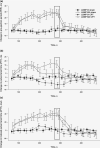Effects of experimental hypovolemia and pain on pre-ejection period and pulse transit time in healthy volunteers
- PMID: 35748055
- PMCID: PMC9226798
- DOI: 10.14814/phy2.15355
Effects of experimental hypovolemia and pain on pre-ejection period and pulse transit time in healthy volunteers
Abstract
Trauma patients may suffer significant blood loss, and noninvasive methods to diagnose hypovolemia in these patients are needed. Physiologic effects of hypovolemia, aiming to maintain blood pressure, are largely mediated by increased sympathetic nervous activity. Trauma patients may however experience pain, which also increases sympathetic nervous activity, potentially confounding measures of hypovolemia. Elucidating the common and separate effects of the two stimuli on diagnostic methods is therefore important. Lower body negative pressure (LBNP) and cold pressor test (CPT) are experimental models of central hypovolemia and pain, respectively. In the present analysis, we explored the effects of LBNP and CPT on pre-ejection period and pulse transit time, aiming to further elucidate the potential use of these variables in diagnosing hypovolemia in trauma patients. We exposed healthy volunteers to four experimental sequences with hypovolemia (LBNP 60 mmHg) or normovolemia (LBNP 0 mmHg) and pain (CPT) or no pain (sham) in a 2 × 2 fashion. We calculated pre-ejection period and pulse transit time from ECG and ascending aortic blood velocity (suprasternal Doppler) and continuous noninvasive arterial pressure waveform (volume-clamp method). Fourteen subjects were available for the current analyses. This experimental study found that pre-ejection period increased with hypovolemia and remained unaltered with pain. Pulse transit time was reduced by pain and increased with hypovolemia. Thus, the direction of change in pulse transit time has the potential to distinguish hypovolemia and pain.
Keywords: hypovolemia; non-invasive; pre-ejection period; pulse transit time.
© 2022 The Authors. Physiological Reports published by Wiley Periodicals LLC on behalf of The Physiological Society and the American Physiological Society.
Figures




References
-
- Ahlstrom, C. , Johansson, A. , Uhlin, F. , Länne, T. , & Ask, P. (2005). Noninvasive investigation of blood pressure changes using the pulse wave transit time: A novel approach in the monitoring of hemodialysis patients. Journal of Artificial Organs, 8(3), 192–197. 10.1007/s10047-005-0301-4 - DOI - PubMed
-
- Bramwell, J. C. , & Hill, A. V. (1922). The velocity of pulse wave in man. Proceedings of the Royal Society of London. Series B, Containing Papers of a Biological Character, 93(652), 298–306. doi:10.1098/rspb.1922.0022 - DOI
-
- Chan, G. S. , Middleton, P. M. , Celler, B. G. , Wang, L. , & Lovell, N. H. (2007). Change in pulse transit time and pre‐ejection period during head‐up tilt‐induced progressive central hypovolaemia. Journal of Clinical Monitoring and Computing, 21(5), 283–293. 10.1007/s10877-007-9086-8 - DOI - PubMed
Publication types
MeSH terms
LinkOut - more resources
Full Text Sources

